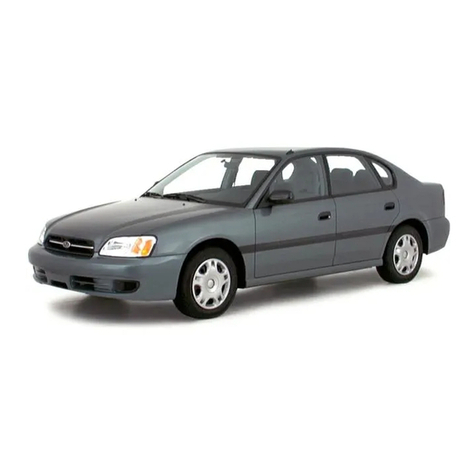
EN(H4DOTC)(diag)-7
ENGINE (DIAGNOSTICS)
General Description
12) Observe the following cautions when installing
a radio in MFI equipped models.
CAUTION:
•The antenna must be kept as far apart as pos-
sible from the control unit.
(The ECM is located under the steering column,
inside of the instrument panel lower trim panel.)
•The antenna feeder must be placed as far as
possible from ECM and MFI harness.
•Carefully adjust the antenna for correct
matching.
•When mounting a large power type radio, pay
special attention to the three items above men-
tioned.
•Incorrect installation of the radio may affect
the operation of ECM.
13) Before disconnecting the fuel hose, disconnect
the fuel pump connector and crank the engine for
more than 5 seconds to release pressure in the fuel
system. If the engine starts during this operation,
run it until it stops.
14) Problems in the electronic-controlled automatic
transmission may be caused by failure of the en-
gine, the electronic control system, the transmis-
sion proper, or by a combination of these. These
three causes must be distinguished clearly when
performing diagnostics.
15) Diagnostics should be conducted by rotating
with simple, easy operations and proceeding to
complicated, difficult operations. The most impor-
tant thing in diagnostics is to understand the cus-
tomer’s complaint, and distinguish between the
three causes.
16) On model with ABS, when performing driving
test in jacked-up or lifted-up position, sometimes
the warning light may be lit, but this is not a mal-
function of the system. The reason for this is the
speed difference between front and rear wheels.
After diagnosis of engine control system, perform
the ABS memory clearance procedure of self-diag-
nosis system.
B: INSPECTION
Before performing diagnostics, check the following
items which might affect engine problems:
1. BATTERY
1) Measure the battery voltage and specific gravity
of electrolyte.
Standard voltage: 12 V
Specific gravity: Above 1.260
2) Check the condition of main and other fuses,
and harnesses and connectors. Also check for
proper grounding.
2. ENGINE GROUNDING
Make sure the engine grounding terminal is proper-
ly connected to engine.
C: NOTE
1. DESCRIPTION
•The on-board diagnostics (OBD) system detects
and indicates a fault in various inputs and outputs
of complex electronic control. Malfunction indicator
light in combination meter indicates occurrence of a
fault or trouble.
•Further, against such a failure or sensors as may
disable the drive, the fail-safe function is provided
to ensure the minimal driveability.
•The OBD system incorporated with the vehicles
within this engine family complies with Section
1968.1, California Code of Regulations (OBD-II
regulation). The OBD system monitors the compo-
nents and the system malfunction listed in Engine
Section which affects on emissions.
•When the system decides that a malfunction oc-
curs, malfunction indicator light illuminates. At the
same time of malfunction indicator light illumination
or blinking, a DTC and a freeze frame engine con-
ditions are stored into on-board computer.
•The OBD system stores freeze frame engine
condition data (engine load, engine coolant tem-
perature, fuel trim, engine speed and vehicle
speed, etc.) into on-board computer when it detects
a malfunction first.
•If the OBD system detects the various malfunc-
tions including the fault of fuel trim or misfire, the
OBD system first stores freeze frame engine condi-
tions about the fuel trim or misfire.
•When the malfunction does not occur again for
three consecutive driving cycles, malfunction indi-
cator light is turned off, but DTC remains at on-
board computer.
•The OBD-II system is capable of communication
with a general scan tool (OBD-II general scan tool)
formed by ISO 9141 CARB.
EN-00070



















































